 By Pepper Parr
By Pepper Parr
September 27, 2014
BURLINGTON, ON.
Story has been updated
The proposal is for a two tower structure on the north side the Appleby Village which is on the north-east corner of the New Street – Appleby Line intersection.

First Capital did a total makeover of the Appleby mall site a number of years ago – they now want to add some residential to a part of the property.
The site has undergone a major upgrade in the past two years and the developer wants to do some intensification. The two buildings would be situated on the north side of the property – fronting on Pinedale.
Anyone can take a building proposal to the city. The bigger developers know the rules; they know that studies have to be done and they know the process.
In this instance, First Capital, the developers, will have read the provincial government policies and be fully aware of the nuances of the provincial Places to Grow policy and they will have hired planners to write the justification reports so that when it is taken to the city hall staff will have a very clear idea as to what the developer proposes to do with their property.
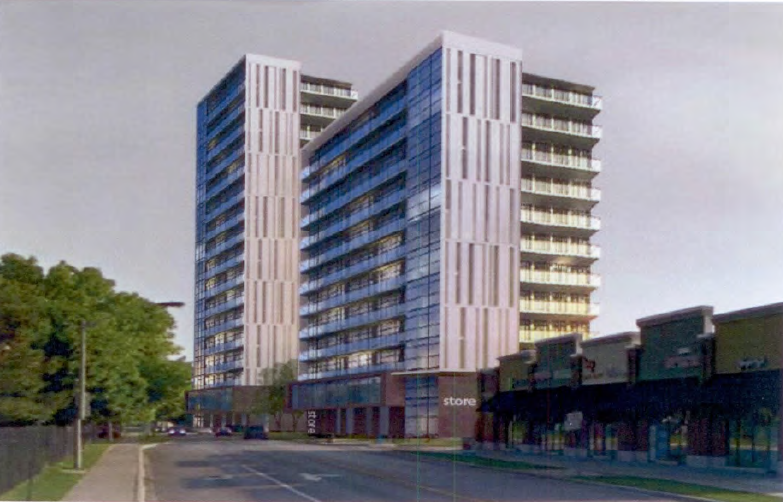
Artists rendering of the two tower apartment complex with one 16 storey and a second 11 storey building that will have underground parking.
This development requires both a change to the current zoning and a change to the Official Plan – both tend to send citizens up a wall. Many don’t understand how a developer can ask for a change in an Official Plan.
Director of Planning Bruce Krushelnicki will explain, as he has done hundreds of times before, that the Official Plan is a dynamic document that is in place to set out what the city said it wants at a point in time.
Developers however are encouraged to bring ideas and proposals to the city. Burlington wants growth – the citizens say we need that growth. When a developer comes along with a proposal the response is often – “well we didn’t mean that kind of growth”.
Part of the process of getting these development ideas before city council for a decision is a Statutory Public Meeting which has been scheduled for November 18th 2014.
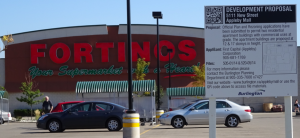
Ward six candidate James Smith beleives the statutory public meeting should be moved back to a date when the new council can make the decision on this project.
That’s a problem for ward five city council candidate James Smith. The new council will be sworn in on December 1st and he wants the Statutory meeting to take place after the new council is in place.
In his letter to Mr. Krushelnicki, Smith said: “As you know this proposed development represents a very large change to the design fabric of the site and the adjacent neighbourhood; to say that this proposal is controversial in our East End neighborhood’s is something of an understatement.”
Smith argues that tabling the Statutory meeting until early 2015 would facilitate important criteria of the City of Burlington’s Engagement Charter, especially when it comes to both Accountability, and Capacity Building.
Turns out candidate Smith didn’t have some of it right. The planner on this file contacted the Gazette and explained that
“we are just starting the required review. One thing that should be clarified is that the November 18 meeting we have scheduled at Robert Bateman High School is NOT the required statutory meeting under the Planning Act.
It is a neighbourhood meeting that the City is holding above and beyond the standard Planning Act requirements, but consistent with our policy to have a meeting for public discussion on major applications prior to any staff reports going to Committee/Council.
I only raise this because I don’t want people in the community to get confused and show up on Nov 18th with expectations that formal decisions are being made on the applications that night and/or that it is their only chance to provide input.
The statutory meeting will be scheduled for a later date, dependent on the file processing timelines and Planning Act requirements, and notification will be provided of this meeting.
In addition, in the case of these applications it is anticipated that staff will be presenting an information report to Committee/Council for consideration before coming back at an even later date with some type of recommendation report.
Smith points out that the City’s engagement charter states: “The City of Burlington will encourage the ability of its citizens and stakeholders to effectively participate in the development and implementation of engagement processes with respect to issues and decisions that affect their lives and their community”.
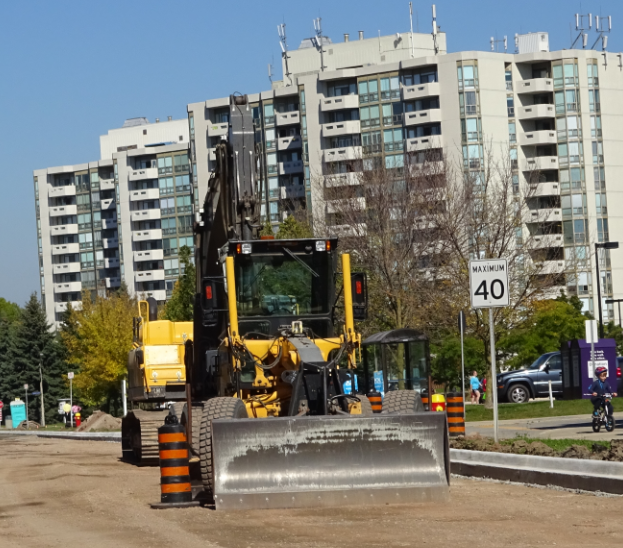
An apartment complex to the east consists of three towers – each 11 storeys high.
Smith also points out that the white signs that asks citizens to visit a website for a meeting in two months is not compliant with the ideal set out in the concept of either Clear Language or Early & Widespread Notification.
“I’m critical under the Clear Language provision, as information signs posted do not have a clear English explanation; only a legalese description; citizens should have both. Widespread notification is deficient, for three reasons: the poor location of information signs, – facing streets that have been under construction for some time, the lack of information signs available in the Plaza itself and lack of illustrations on the information signs.
Besides wanting the public meeting date changed Smith adds some comments on the development proposal. “The site plan as proposed further exacerbates the deficiencies of the present site as it pertains to Pedestrian, Bicycle, Transit and Vehicle traffic flow, nor does the plan address the lack of street frontage of the businesses on this site.”
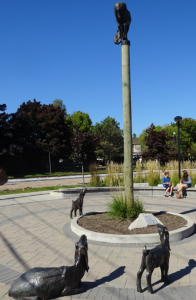
Public art is set at the north west corner of the Village. Goats.
For the record, said Smith, I am a supporter of the Province’s Places To Grow policy and firmly believe we need to intensify some of our underused sites in Burlington. However; given the examples in the province’s policy guide and the fact that the City of Burlington does not have hard design guidelines for this kind of rezoning application or for so-called Transit Friendly Design, I believe we need to take some time, as a city, to produce such documents in collaboration with our citizens and the development industry.
This way we can get the kind of intensification our citizens can generally agree upon and avoid long, and costly protracted battles between citizens, the city and the development community.
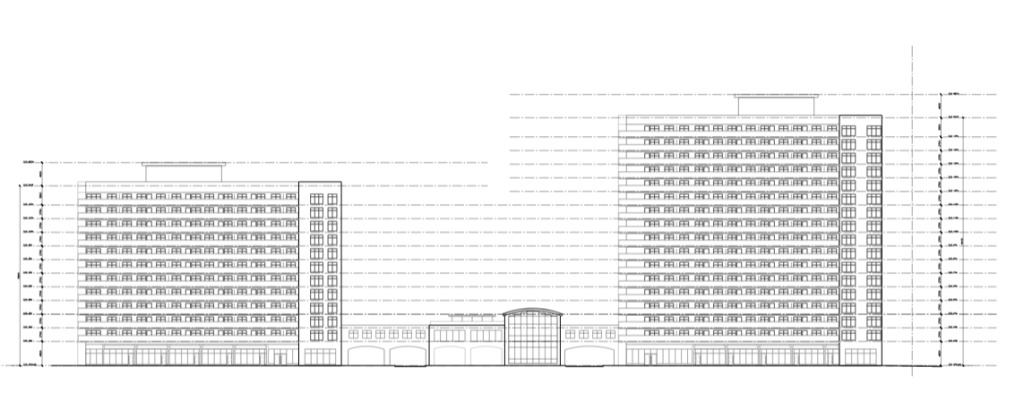
South elevation of the two proposed towers.
The developer sets out details on the location: Appleby Village consists of seven (7) buildings with a variety of retail/service commercial/office uses, including a Fortinos grocery store, Home Hardware, Rexall Pharma Plus, LCBO and the Beer Store. The Gross Building Floor Area (“GBFA”) within Appleby Village is approximately 20,056 square metres (215,881 square feet).
The 6.6 hectare (16.3 acre) site is bound by, on the immediate north by Pinedale Avenue, where there are three condominium high-rise buildings known as Pinedale Estates which were built in 1989. The three buildings are each 12 storeys and provide a total of 338 dwelling units.
To the south and east of Pinedale Estates, there are two elementary schools (Ascension Catholic School and Frontenac Public School) Robert Bateman High School) with associated parkland.
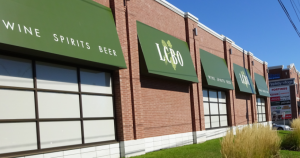
Smith would like to see storefront access to the street for those who walk – just about all the retail locations open out to the inner parking lot.
The Provincial Policy Statement, Places to Grow, states: “it is in the interest of all communities to use land and resources wisely, to promote efficient development patterns, protect resources, promote green spaces, ensure effective use of infrastructure and public service facilities and minimize unnecessary public expenditures.” It is a key Provincial policy to promote land use
patterns that are transit-supportive and to accommodate a range of intensification opportunities.
Density is almost always an issue for the people of Burlington. Current targets call for a minimum number of new housing units to be added to the built-up area between 2015 and 2031 as 8,300.
The phasing for these units are: 2,525 by 2016; 2,758 between 2017 and 2021; 2,669 between 2022 and 2026 and finally 2,659 between 2027 and 2031 by which time we will all be looking at a much different Burlington.




















When I saw the sign go up in the Fortinos parking lot, I immediately looked it up on the City website. As it wasn’t clear as to whether is was going to be rentals or condos, I e-mailed the city contact person. I received a reply in which it was it was confirmed that it was going to be condos.
Some very interesting comments and views here. I also live close by Appleby Village and one of my questions is whether these planned high rise units are going to be rental apartments or condo units? I’ve looked at the posted documents, and they are just stated as “Residential Towers”. Does anyone know?
The other item is whether there will be some improvements and ways to alleviate some of the Appleby Line traffic once these are built. Morning and afternoon rush hour traffic can be “fun” … especially if the highway is at a standstill and people are trying to find an alternate route.
Editor’s note: We understand these are to be rental units.
This story update is good news and especially, a chance for citizens to be heard, and I hope, educated by planning staff on the policy frame they are working within, and how this applications fits or does not fit within it.
The citizens now have until November 18 to get as educated as they can, and to get their own positions and policy language together so they can actively and meaningfully participate in the meeting. Citizens need to be prepared to put a position on the table that describes what they want to see, don’t want to see, and why.
Remember, something is going to be built on that site, so you can’t just complain about it.
Nothing is ever done in isolation. We live in an interconnected system where everything is tied into everything else. A change in one part of the system changes the whole system. I would think the City Official Plan recognizes this fact This means that changes to Appleby Village mean drastic changes in the total community system. This proposal means we would be faced with overcrowding, overuse of old water mains that have already been stressed with recent floods, parking and transportation problems, safety issues with schools nearby, and two unsightly towers that do not fit the community. There are just so many people that can be forced into a small space. This is not the space for the towers.
To many people, change is something to fear. If it’s not there now, they don’t want it – not ever. I remember the cries of fear when the Appleby Village proposal was made public, and look at it now. The developer did a first class job of redeveloping the property and it looks tremendous.
While citizen engagement is an important part of the process, people sometimes have the mistaken notion that the result of their involvement has to be the adaptation of their position. While everyone should participate and make their views known, we have to keep in mind that having an opinion is one thing; the best possible outcome for the community and the city is another.
Like many people, I intend to stay in my house as long as possible before selling and moving into something more manageable for a senior. A development such as this will give me the opportunity to live within a stone’s throw of many conveniences and make it possible to stay in my neighbourhood.
It’s also worth noting that increased density usually brings increased property values along with it.
I’m not sure where Seamus is getting his ideas about citizens having mistaken notions about their involvement resulting in adoption of their position. What citizens want is meaningful input into the decisions that are made, especially about developments that directly affect their lives and neighborhoods, and look like they need OP amendments and by-law changes that enable developments people did not expect from the OP in place when they settled in their area.
And regarding opinions, citizens want a meaningful forum where not just opinions are expressed, but issues, concerns, informed critical comments, are able to be discussed. We don’t want stage managed single event public meetings where all kinds of for and against opinions are expressed, but there is no further consultation with citizens that discusses and integrates these opinions, and provides real meaningful input into the decision framework and process, and final recommendation, with citizen provided rationales.
The comment of Seamus that disturbs me the most is the following, I copy here;
“While everyone should participate and make their views known, we have to keep in mind that having an opinion is one thing; the best possible outcome for the community and the city is another.”
I ask, who provides the opinion that something is the best possible outcome, etc? That’s the decision that citizens want a say in. They don’t want some distant staff group and Councillor doing this, with no visible validation of what citizens think and want. So what citizens want is participation in the decision process that puts together all the various expressed comments, concerns, and “opinions”, into a decision-making process map where citizens have a visible and meaningful input.
The staff reports are also just “opinions”, but determining what is best all things considered deals with a higher logical type, a class of opinions, that should not confused with the lower logical type of individual opinions. These two different levels should not be thought of as the same. Citizens want a say at both levels, and especially moving from the opinion level, to the higher level of sorting out, discussion, and integration that determines a “best” outcome.
Much citizen discontent is based on having their “opinions” labelled as merely their own view, and then dismissed as just part of a controversy that is stated to exist because people may have different opinions. This contrived “controversy” may then be used to impose a decision made by staff or what the Councillor wants for his own interest and agenda.
Whatever the case, the citizens directly affected have their views short circuited, and they find this hateful. In the busy lives that people in Burlington generally live, this kind of situation often leads concerned people to give up and drop out because they don’t think anyone with authority is listening, and what they say doesn’t matter.
No way to run a supposedly democratic city that says it wants citizens to “Get Engaged” in things that affect their daily lives. I would think that your street or neighborhood would so qualify.
But if the powers that be want what they want, then it’s a perfect way to end run what citizens really want but have no say in by design.
I’ve taken part in community workshops and citizen engagement exercises in the past. There is always someone, or a group, whose ideas are in opposition to the outcome.
These people often complain that there was insufficient public engagement, or even no engagement at all because the city didn’t side with them. Others have the foolish notion that democracy has been denied them.
The fact that the decision makers take a different position doesn’t mean people weren’t given a sufficient opportunity to participate. It means Council and the mayor felt that a different direction was better for the city.
So yes, people sometimes have the mistaken notion that the result of their involvement has to be the adaptation of their position.
And I’ll be very blunt – we all have positions on the direction of our community, but merely having a position doesn’t necessarily make it valid.
I’m getting the impression that you are too scornful of citizen participation and engagement, saying they are never happy, so why bother. The city has not really even began to implement the engagement charter, and past “engagement”, if you can call it that, is largely stage managed statutory information meetings (PICs) where citizens are told what the city has basically already decided to do. Oh, they can fill out a comment form if they want, and thanks, good-bye.
In any case, my comments are about a sketch of what citizens would like to see for a process. They have good ideas about what they want to see as a process map, and they want a meaningful say in the decision-making.
That’s the point – citizens want transparent, participatory process. The outcome, whether you get what you want, is another matter. They just don’t want to be told the decision has been made, too bad, you don’t know what’s best. That seems to be what you support, and to be blunt, it’s not valid.
You have the wrong impression of my comment Tom.
Those who are in opposition to what the City decides tend to complain loudly that they weren’t given a sufficient opportunity to engage the process, regardless of the fact that they were heard.
My point regarding citizen engagement, therefore, is that we’re not all going to agree with the City – or one another – on every topic, and to suggest that you were denied democracy just because your idea wasn’t adopted is disingenuous.
OK, and I would add that impressions and differences in views can be at least somewhat resolved when the process of engagement, what we have done here, is long enough to have a serious exchange.
Thus, I would argue that citizen opposition and complaint arise because of what you said, insufficient opportunity to engage the process. Merely being heard at a stage managed PIC, or at a Committee meeting considering a staff recommendation report to Council, are not enough.
The engagement process needs more steps and time to educate and allow citizens to develop an informed position to take to the city, and be heard fully. I agree that agreement all the time or with each other is not realistic, but with sufficient opportunity to discuss and debate what the proposal on the table is based on, you can’t expect to always have your position adopted.
Transparency of process, detailed explanation of decision criteria and policy framework necessary to work within, how these criteria and policies were integrated, and why the city decision is what it is, and why it might differ from yours, are of paramount importance to people.
That’s one reason why I agree with Councillor Meed Ward’s suggestion to have citizen workshops that will educate and inform citizens about the process and all the other things that planning has to deal with and how they arrive at their decision and recommendations. Out of this workshop context and the other steps in engagement, citizens will be much better prepared to get organized and present what they want and why.
A lot of rancour and complaint could be avoided, or at least not substantiated, I think. If after all of this process, and extra workshop steps, you still disagree with the decision made, as long as no back-stabbing, back-room deals have been made, then that’s what it is.
It’s the process!!!
I think Mr. Smith has a valid point regarding putting off the public meeting until the new Council is in place.
Also, I agree there is a big need to implement the Engagement Charter. We need leadership from City hall to do this, and citizens need to make this a priority to get going on with the new council.
I also suggest that Ward 2 Councillor Meed Ward’s idea of citizen workshops on important issues would be a welcome and very good added citizen engagement and consultation process. This would be in addition to the statutory public meeting which is a minimal provincial requirement.
The public meetings are just too official and do not give citizens, who get 10 minutes only, a real understanding of the issues and the planning context and policy frame. With this workshop education and background the citizens can then better participate in the discussion and decision-making part of the workshop(s) process.
Instead of having to come to Council with a for or against position, citizens can debate and discuss the plans, and make a meaningful and intelligent contribution. There are many ways to structure these things, but the main thing is to get started.
Maybe we can see why the rest of Council has been less than receptive to Meed Ward’s ideas – too much citizen talk and ideas encroaches on the decision-making power.
Is this really necessary – New / Pinedale is already a traffic knot – does intensidication mean build on every square inch. When Appleby Mall was demolished and Appleby Village built – why was this not worked into the plan. There was a public meeting some years ago to redevlop the mall – the city councillor now mayor told the poeple attending not to worry – guess residents should now worry.
Gotta love the Orwellian like term used, “intensification”. The
term, “overcrowding” would be more, honest, and accurate.
In many ways, this is the ideal type of development for Burlington. Residents will have access to many of the services they need within easy walking / biking distance. It makes use of dead space – what is right now a parking lot and brings eyes on the street, which will increase safety. No existing neighbourhoods have to be impacted to accommodate the growth. There are high capacity arterial roads. The additional tax revenue will help with the burden of maintaining that infrastructure, which reduces tax bills for Burlington residents. Many malls / plazas are adding in a mixed use component in order to defray the enormous cost of maintaining them in the long term. We have a lot of land in Burlington that is used up by single story retail surrounded by parking lot that has so much more potential to support walkable mixed use.
The biggest concern I have is the use of cheap materials that will quickly degrade. The cladding used on the Pinedale side in the rendering appears to be cheap and flimsy. Because these buildings will be the visual focus of the neighbourhood for the next 50-100 years at least, it is imperative they are built with quality materials.